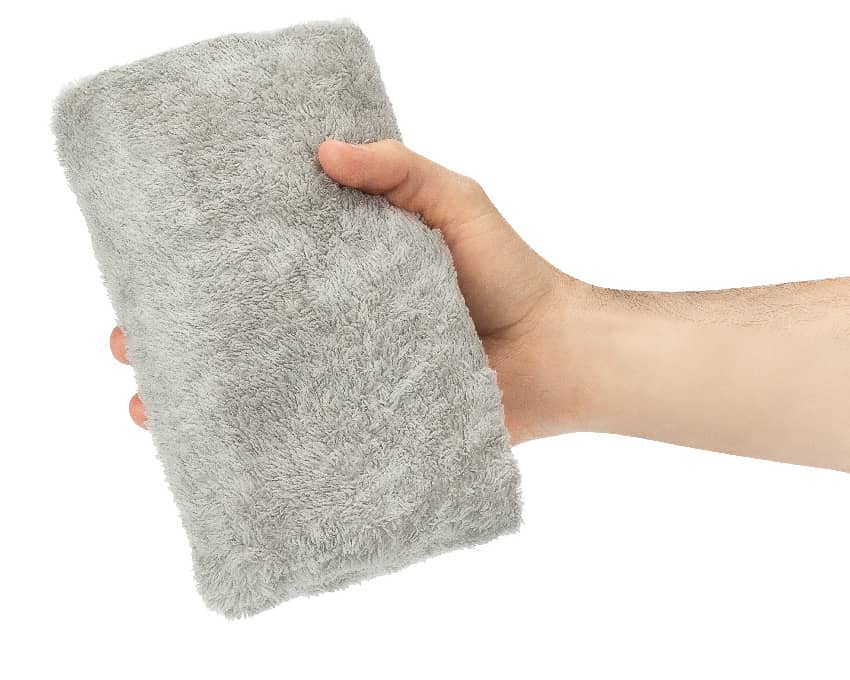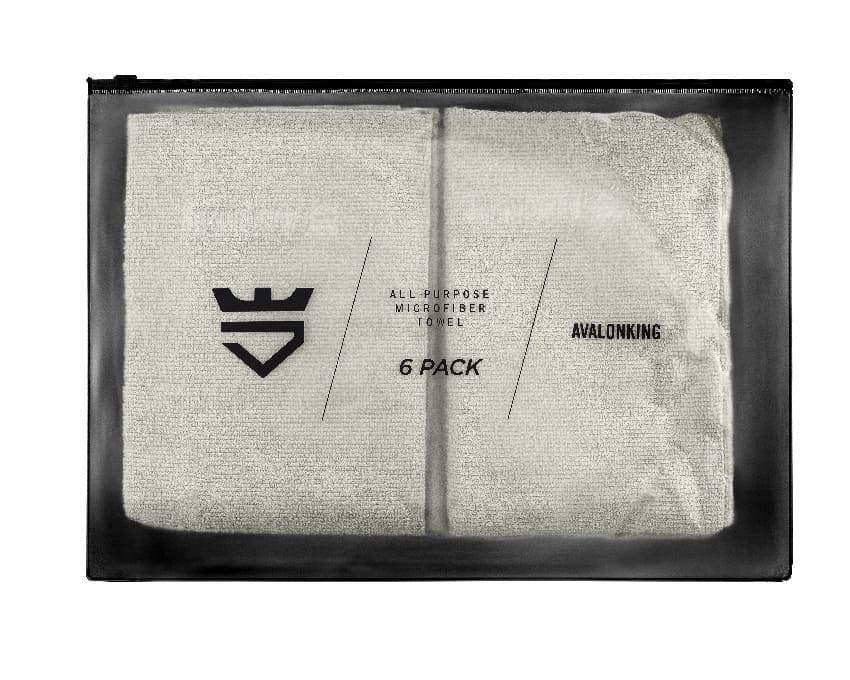For those of you who read the AvalonKing guide to “Buffing 101,” chances are you now understand the different methods and materials that are required to create a mirror-like finish on automotive surfaces.
Today, in “Buffing 102,” we will dive a bit deeper, and investigate the many sides of microfiber buffing products, for these unassuming cloths are far more complex than one might expect.
The reason for today’s acute focus on microfiber, is in response to all of the misleading information we’ve discovered. Poor buying decisions based purely upon inaccurate data remain all too common, and here at AvalonKing we believe that an informed customer is an empowered DIY enthusiast.
In the information below, we’ll provide an in-depth review of what goes into making microfiber, and why it matters so much. We’ll also talk a bit about things like GSM, material styles, and what kinds of microfiber work best in various situations.
Ready to study-up and become a microfiber product info buff? Well, today is your lucky day…
What Makes Microfiber So Special?

Not all buffing products are made equal. Even within individual product categories, the quality of the materials used and the production methods implemented can impact a microfiber cloth’s ability to remove contaminants and add shine.
The Split, Explained
Microfiber is concocted from two synthetic materials: Polyamide (a byproduct of nylon) and polyester. The ability of these two fibers to interlock with one another is what makes microfiber less prone to scratching surfaces, and so damn good at penetrating microscopic crevices. This also allows the material to absorb debris and microscopic chemical substances at a staggering rate, and prevents them from smearing gunk across a surface.
As a microfiber buffing cloth is constructed, the two synthetic materials that compose its structure are woven together in a pie-shaped loop pattern, which is commonly referred to as “the split.”
When a microfiber buffing product is used, the two forms of fiber split apart under varying degrees of surface tension. This allows the split fibers to penetrate areas where normal cotton cloths cannot go, thus collecting contaminants and chemicals without scratching the surface.
The University of California, Davis Medical Center compared the amount of bacteria picked up by a cotton-loop mop and by a microfiber mop. The cotton-loop mop reduced bacteria on the floors by 30%, whereas the microfiber mop reduced bacteria by 99%.
Department of Environmental and Occupational Health Sciences
University of Washington
The Ratio
When it comes to blending polyester and polyamide microfiber strands, there are two ratios that are most commonly used. An 80/20 mix, and a 70/30 polyester to polyamide blend.
Traditionally it was thought that the 70/30 ratio was the more absorbent mix. However, many modern microfiber buffing and cleaning materials have their own proprietary blend somewhere between the two, as experts claim that the manufacturing process and materials are what truly matter.
Microfiber Materials
Another factor that impacts the grade of a microfiber buffing product, is the quality of the materials used in its construction. While the average person may assume that polyester and polyamide are of the same quality across the board, there can be some pretty steep variances in the grade of the final product.
Assuming that all polyesters and polyamides are of the same quality, is like saying that all tequila is the same, regardless of brand or ingredients used. Sure, the raw materials may be similar, but the quality of those base products, and the way in which they are processed and packaged can make a huge difference in the quality of the final product.
Quick Nerd Note: The diameter of a single microfiber strand is calculated via a unit of measurement called “denier.” In order for a material to be classified as microfiber, it must not have a rating anywhere above 1 denier, or 10 micrometers. A good rule of wrench is to look for a microfiber product rocking a rating that is below 0.5 denier, as this will allow it to absorb even the tiniest contaminant, including bacteria!
What is a Microfiber GSM Rating?

While materials and structural design definitely matter, GSM, or “Grams Per Square Meter,” is the secret ingredient that ties the complex microfiber maze together.
It is a microfiber’s GSM that constitutes the cloth’s absorbency levels, and how well it will hold up over the long haul. The higher the GSM rating, the thicker and softer the material, which for microfiber buffing towels, translates to how well it can remove protectants and chemicals, and leave behind a brilliant shine.
The increased surface area of the fibers and their star shape also allow them to absorb up to 7–8 times their weight in liquid.
Quick Nerd Note: Microfiber filaments are oftentimes thinner than one percent of the diameter of a human hair. Hence the “micro” part of the microfiber namesake playing a leading role.
What Type of Microfiber Towel Should I Use?

Now that you have a general understanding of the basic microfiber terminology, and what goes into making these complex textiles, it’s time to make a purchase.
But with so many microfiber towel options on the market, how is one to know which product is appropriate for the task at hand?
General-Purpose Microfiber Towels

All-purpose microfiber towels are exactly what they appear to be on paper. The average multi-task microfiber towel is typically comprised of a 16″ x 16″ cloth, packing an 80/20 blend, and a GSM rating in the 250–300 range.
Absorbent enough to be used on most liquids, but light enough that it remains inexpensive, the all-purpose microfiber towel features a lengthier loop, or “hooked” design, which helps it trap larger contaminants, and spread liquid protectants evenly over a surface.
Another strong-suit for multi-purpose microfiber cloths, is their ability to safely remove sticky and rough substances, like bug splatter and brake dust from painted and glass surfaces. The “general-purpose” namesake means that this kind of microfiber product is safe to use on everything from painted metal surfaces and exposed plastics, to glass, leather, vinyl wrap, chrome, fiberglass, and much more.
Microfiber Glass Cleaner Towels

Glass cleaning microfiber cloths are similar in design to the average all-purpose microfiber towel, but with one major difference: They are pretty much completely lint-free. This feat is achieved via the weave pattern and nap depth of the fibers themselves, which on a glass cleaning microfiber cloth tends to be both far tighter and much lower than average.
Due to their super-tight structure, microfiber glass cleaning towels also grip extremely well, which makes them ideal for scooping-up watery glass cleaning liquids. Most glass cleaning microfiber cloths feature an 80/20 construction, with a GSM rating landing anywhere between 250–300.
Quick Tip: Proper microfiber care is a very important piece of the DIY detailing puzzle. Knowing how to wash, decontaminate, dry, and store microfiber cloths is a must if you plan on using these useful tools. For more on this subject, see our blog article focusing on proper microfiber cloth care.
Microfiber Drying Towels

There are two primary types of microfiber drying towel weave constructions: Waffle weave and terry weave. Each offers different benefits, multiple grades of GSM, and comes in its own unique composition.
Waffle Weave Drying Towels

The most common drying towel is the waffle weave design, which has seen a massive spike in popularity over the years due to its modest price point and widespread availability. Waffle weave fabric is typically cross-stitched in a waffle pattern, which makes it less expensive to manufacture, and allows it to easily absorb moisture as it glides over a surface.
The downside to this design, is that once the towel becomes completely saturated, you have to wring it out and let it fully dry. If you decide to use a waffle weave microfiber towel while it is still wet, you’ll be left with a shit-ton of streaks, which having a large stack of waffle weave drying towels on hand during wash day. Waffle eave microfiber cloths are typically an 80/20 blend, with GSM ratings ranging from 350, all the way up to 600.
Terry Weave Drying Towels

Terry weave drying towels are also referred to as “ultra-plush” microfiber towels, and for damn good reason. The material is incredibly soft, with two-sided designs featuring a very long pile on one side, and a much shorter pile on the back. In most scenarios, this creates an extra absorbent structure that allows the user to dry large surfaces with just a single product.
A high-quality terry weave drying towel will be a 70/30 construction and range anywhere from 1,000–1,150 GSM. This is about as high as microfiber cloths go on the GSM scale, as anything above that makes the towel too thick, and difficult to wring-out and dry in a timely fashion.
Microfiber Buffing Towels

A microfiber towel that’s been designed with buffing in mind, is going to fall somewhere between an all-purpose and a drying towel. The best ones are a 70/30 blend, for polyamide is very good at absorbing flashed, or partially hardened liquids on a surface area.
But unlike general-purpose microfiber towels and ultra-plush drying microfibers, buffing cloths are not just about absorbing moisture or removing filth. These products are intended to provide a surface with a streak-free shine, all while removing any residual detailing or protectant products that may be produced during an application.
Buffing towels that are intended to be used with waxes and sealants are almost always produced with a shorter, tighter weave. Whereas microfiber buffing towels with a deeper, plusher construction, are best for removing things like ceramic booster sprays and for adding shine to an already protected surface.
Parting Shots

While there are numerous other microfiber products on the market that a DIY enthusiast can use on their automobile, like a microfiber chenille wash mitt, the core cloths listed above are what you’ll likely encounter most often.
However, while microfiber may be an incredibly useful weapon in the endless war on airborne contaminants, its role is to absorb and add shine, not protect. For that sort of thing you’ll need a hardcore surface protectant, which is precisely why Armor Shield IX continues to rule the roost as the king of all consumer-grade ceramic coatings.
And yes, each Armor Shield IX kit comes with its own dedicated microfiber buffing towel, and yes, you can still buy additional buffing cloths and multi-purpose microfiber towels at your leisure on the AvalonKing website.













2 comments
Tim Charlet
Hi John:
The buffing towel that we’ve included in the DIY kit is enough to remove the residual off each application. Stick with that one, and make sure to switch sides of the buffing towel after each side of the vehicle or after the first coating.
Hi John:
The buffing towel that we’ve included in the DIY kit is enough to remove the residual off each application. Stick with that one, and make sure to switch sides of the buffing towel after each side of the vehicle or after the first coating.
john w byrne
Thanks for the great article. I’m going to apply Avalonking next weekend. In addition to the microfiber towel provided in the package, should I use additional towels in this process? If so, can you recommend a brand I can buy?
Thanks
John Byrne
Thanks for the great article. I’m going to apply Avalonking next weekend. In addition to the microfiber towel provided in the package, should I use additional towels in this process? If so, can you recommend a brand I can buy?
Thanks
John Byrne